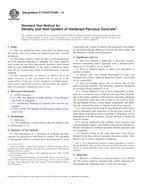We need your consent to use the individual data so that you can see information about your interests, among other things. Click "OK" to give your consent.
ASTM C1754/C1754M-12
Standard Test Method for Density and Void Content of Hardened Pervious Concrete (Withdrawn 2021)
Automatically translated name:
Standard Test Method for Density and Void Content of Hardened Pervious Concrete
STANDARD published on 1.5.2012
The information about the standard:
Designation standards: ASTM C1754/C1754M-12
Note: WITHDRAWN
Publication date standards: 1.5.2012
SKU: NS-12366
The number of pages: 3
Approximate weight : 9 g (0.02 lbs)
Country: American technical standard
Category: Technical standards ASTM
The category - similar standards:
Annotation of standard text ASTM C1754/C1754M-12 :
Keywords:
density, hardened density, pervious concrete, void content, ICS Number Code 91.100.30 (Concrete and concrete products)
Additional information
| Significance and Use | ||||||
|
This test method is applicable to pervious concrete mixtures containing coarse aggregate with a nominal maximum size of 25 mm [1 in.] or smaller. This test method applies to either core specimens or molded cylinders. Density and void content determined by other test methods may produce different numerical results, which may not be comparable. This test method allows one to choose one of two different drying methods. The following should be considered in selecting Drying Method A or B. Drying Method A uses a lower temperature to determine the constant dry mass of the pervious specimen. Depending on the initial condition of the pervious specimen, obtaining the constant dry mass may take as long as one week or more. Drying Method B uses a much higher temperature and therefore the constant dry mass is attained much more quickly. Specimens tested using Drying Method B shall not be used to determine other properties of the pervious concrete. If other physical properties such as strength or infiltration will be determined from the specimen, Drying Method A should be used for testing. Drying Method B may produce lower densities and correspondingly higher void contents than Drying Method A. Results from the two methods should be treated separately and not combined. Repeat testing of the same specimen using Drying Method A has been shown to produce dissimilar results. Only the first set of results should be considered. Note 1—It is believed that exposure to high temperatures, as used in Drying Method B, may alter the void structure of the pervious concrete matrix by causing shrinkage cracks in the cement paste at the aggregate interface. |
||||||
| 1. Scope | ||||||
|
1.1 This test method provides a procedure for determining the density and void content of hardened pervious concrete specimens. 1.2 The values stated in either SI units or inch-pound units are to be regarded separately as standard. The values stated in each system are not exact equivalents; therefore, each system shall be used independently of the other. Combining values from the two systems may result in nonconformance with the standard. 1.3 This standard does not purport to address all of the safety concerns, if any, associated with its use. It is the responsibility of the user of this standard to establish appropriate safety and health practices and determine the applicability of regulatory limitations prior to use. |
||||||
| 2. Referenced Documents | ||||||
|
Similar standards:
Historical
1.3.2014
Historical
1.10.2009
Historical
1.10.2011
Historical
1.4.2013
Historical
1.4.2012
Historical
1.2.2004
We recommend:
Technical standards updating
Do you want to make sure you use only the valid technical standards?
We can offer you a solution which will provide you a monthly overview concerning the updating of standards which you use.
Would you like to know more? Look at this page.



 ASTM C469/C469M-14..
ASTM C469/C469M-14.. ASTM C470/C470M-09..
ASTM C470/C470M-09.. ASTM C490/C490M-11e1..
ASTM C490/C490M-11e1.. ASTM C494/C494M-13..
ASTM C494/C494M-13.. ASTM C495/C495M-12..
ASTM C495/C495M-12.. ASTM C496/C496M-11..
ASTM C496/C496M-11..
 Cookies
Cookies
